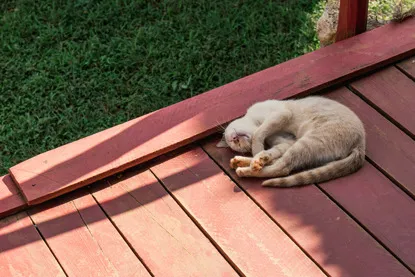Bringing a cat into your home means understanding their natural behaviors, and one key aspect is toileting. Many cat owners wonder how to teach your cat to toilet outside, especially if they want to reduce indoor litter use while keeping their pet happy and healthy. Domestic cats descend from African wildcats that thrived in sandy environments, instinctively burying waste to avoid predators. Though house cats face fewer threats, this instinct remains strong. Modern gardens often lack the ideal setup, so creating an appealing outdoor toilet can make the transition smooth and stress-free.
If you’re transitioning your cat to outdoor toileting, patience is essential. Cats prefer specific conditions like soft digging material and privacy. By mimicking their wild habitat, you encourage natural behavior without force. For more on cat litter habits, check out is toilet training your cat bad.
 Ginger cat relaxing on garden decking
Ginger cat relaxing on garden decking
Choosing the Right Toilet Material
The foundation of success lies in the substrate. Cats need loose, diggable material to bury their waste effectively. Soil or fine play sand works best, as it’s similar to their ancestral terrain and easy on paws. Avoid gravel or bark, which can be too coarse and discourage use.
One practical option is an outdoor litter tray filled with your chosen material. Place it in a sheltered spot to keep it dry. Alternatively, dig a custom pit matching a standard litter tray size (about 18×14 inches) or larger, lining it with sand or soil. Maintain it year-round—top up material weekly and sift out waste to prevent odors. In freezing winters, cover it or provide a heated alternative to avoid crusting.
Veterinarians from organizations like the International Cat Care recommend monitoring for signs of discomfort, such as avoiding the spot, which could indicate urinary issues. Always consult a vet before major changes, ensuring your cat’s health supports outdoor access.
Selecting the Perfect Location
Privacy is paramount for cats during toileting, a vulnerable moment akin to humans seeking seclusion. Position the toilet in your cat’s “core territory”—close to the house, ideally at the garden’s edge rather than the center. This minimizes exposure to neighborhood cats or loud noises like traffic.
Surround the area with bushes, tall grasses, or fencing for camouflage. A 3-4 foot high enclosure adds security without feeling confined. Test by observing your cat’s preferences; some favor sunny spots, others shaded nooks. If you have multiple cats, create separate sites to prevent territorial disputes.
Related reading: Discover if do cats need potty training for indoor-outdoor balance.
 Tabby kitten peering around a tree for privacy
Tabby kitten peering around a tree for privacy
Timing Your Training Efforts
Warm, dry weather is ideal for introducing the outdoor toilet. Summer or spring allows easy digging and pleasant conditions, boosting appeal. In rainy seasons, cats may resist wet soil, so use a waterproof cover or raised tray.
Build a simple shelter with plywood and plastic sheeting to block wind and rain. Gradually transition by placing soiled indoor litter in the new spot, transferring scents that guide your cat. This scent-marking technique, endorsed by feline behaviorists, can take 2-4 weeks.
Don’t remove the indoor litter tray abruptly. Cats need options, especially during stress like moves or illness. Track usage with a journal, noting patterns to refine the setup.
Maintaining Both Indoor and Outdoor Options
Success doesn’t mean ditching the indoor toilet. Keep it clean and accessible indefinitely—cats choose based on comfort. A well-designed outdoor spot will naturally draw preference, reducing litter costs and odors indoors.
From personal experience with rescue cats, combining options prevents accidents. One client I advised transitioned her tabby fully outdoors after three months by consistently refreshing sand and praising post-use visits with treats.
Experts like those at Cats Protection emphasize gradual changes to avoid stress-related issues like spraying. Regular vet check-ups ensure no underlying problems, such as bladder stones, hinder progress.
Final Thoughts on Outdoor Cat Toileting
Teaching your cat to toilet outside requires replicating their natural needs: diggable substrate, privacy, and weather protection. Start with quality material near the house, time it for good weather, and always retain indoor access. With consistency, most cats adapt happily, enjoying the freedom while staying healthy.
Consult your veterinarian for personalized advice, especially for kittens or seniors. Ready for more cat care insights? Explore our guides on feline behavior and training today!
References:
- Cats Protection: Outdoor Toileting Advice
- International Cat Care: Feline Behavior Guidelines
